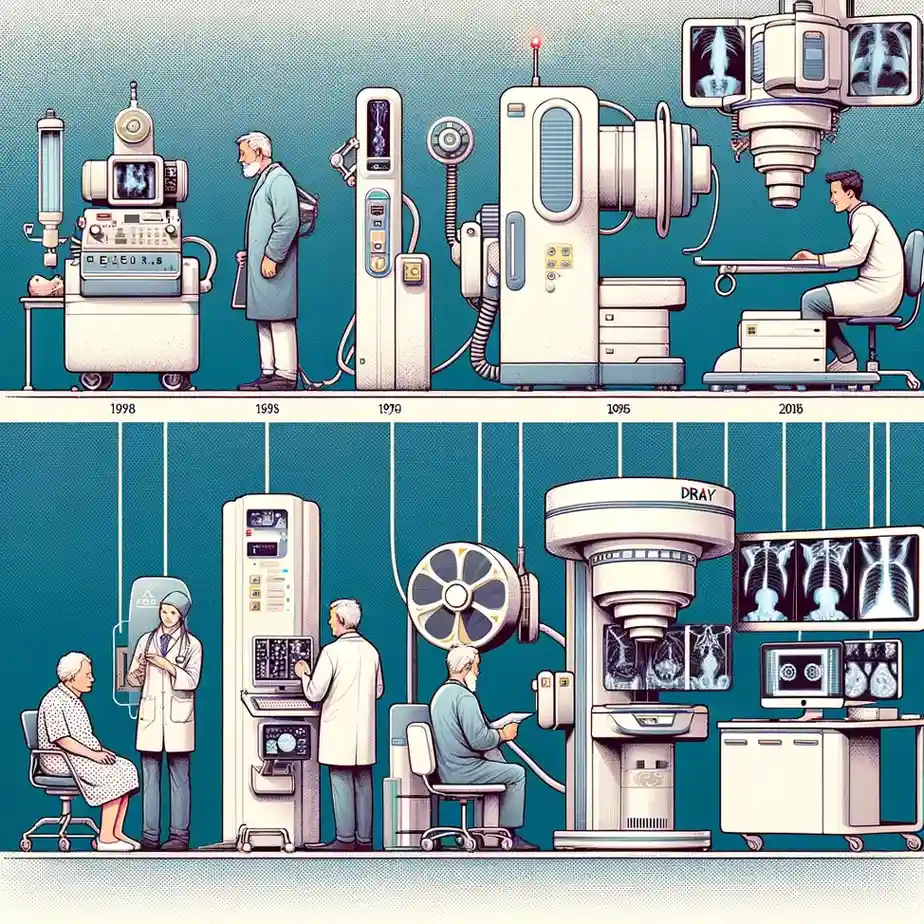The journey of X-ray technology from its inception to the digital age is a fascinating tale of scientific advancement and its profound impact on healthcare. Since Wilhelm Conrad Röntgen discovered X-rays in 1895, this technology has become indispensable in medical diagnostics, allowing healthcare professionals to peer inside the human body without invasive procedures. This blog explores the evolution of X-ray technology from analog to digital, highlighting the benefits and advancements of digital X-ray systems over traditional methods.
A Leap into the Digital Realm
Transitioning from analog to digital X-ray technology marks a significant milestone in medical imaging. Analog X-rays, which use film to capture images, have been gradually phased out by digital systems that employ advanced sensors to directly capture and store images digitally. This shift mirrors broader technological advancements and has led to substantial improvements in diagnostic imaging.
Enhanced Image Quality
Digital X-ray technology offers vastly superior image quality compared to analog systems. With digital systems, radiologists can adjust the brightness, contrast, and zoom of an X-ray image after it has been taken, which is impossible with analog film without retaking the entire X-ray. This flexibility ensures that even the smallest details are visible, leading to more accurate diagnoses. Studies have shown that digital X-ray systems can produce images with greater clarity and detail, significantly improving the ability to detect conditions such as fractures, tumors, and lung diseases.
Reduced Radiation Exposure
One of the most significant benefits of digital X-ray technology is the reduced exposure to radiation for patients. Digital X-ray systems are much more sensitive to radiation than traditional film, meaning they can produce high-quality images with a fraction of the radiation dose. Research indicates that digital systems can reduce radiation exposure by up to 50% compared to analog methods. This reduction is a critical advancement in ensuring patient safety, especially for individuals requiring multiple scans or those particularly vulnerable to the effects of radiation, such as children.
Faster Diagnosis and Enhanced Accessibility
Digital X-ray technology streamlines the diagnostic process, offering faster results than ever before. Images are available immediately after they are taken, eliminating the need for film development, which can be time-consuming. This immediacy facilitates quicker diagnosis and treatment decisions, significantly benefiting patient outcomes. Moreover, digital images can be easily shared among healthcare professionals via digital networks, enhancing collaboration and access to expert opinions regardless of geographical barriers.
The Role of Ecotown Diagnostics
At Ecotown Diagnostics, we embrace the latest advancements in digital X-ray technology to offer our patients the highest standards of diagnostic imaging. Our advanced digital X-ray systems ensure minimal radiation exposure, superior image quality, and rapid results, contributing to a seamless and efficient diagnostic experience. By choosing Ecotown Diagnostics for your X-ray needs, you benefit from cutting-edge technology coupled with our commitment to patient care and safety.
Frequently Asked Questions (FAQs)
Q1: Is digital X-ray imaging safe?
A1: Yes, digital X-ray imaging is considered safe for most patients. It significantly reduces radiation exposure compared to traditional analog methods, making it a safer option for obtaining diagnostic images.
Q2: How does digital X-ray speed up the diagnosis process?
A2: Digital X-ray images are available immediately after being captured, eliminating the need for film development. This immediate availability allows for quicker review by healthcare professionals, leading to faster diagnosis and treatment planning.
Q3: Can digital X-ray images be shared with other doctors?
A3: Yes, one of the advantages of digital X-ray technology is the ease with which images can be shared. Digital images can be quickly sent to and reviewed by other doctors, even if they are in different locations, facilitating better collaboration in patient care.
Q4: Are digital X-rays more expensive than traditional X-rays?
A4: The cost can vary depending on the facility and the specific procedure. However, the efficiency and diagnostic benefits of digital X-rays often outweigh any potential increase in cost, especially considering the long-term health benefits and reduced need for repeat scans.
Q5: How can I prepare for a digital X-ray examination?
A5: Preparation for a digital X-ray is similar to that for an analog X-ray. You may be asked to remove jewelry or wear a hospital gown to prevent obstructions in the image. Your healthcare provider will give you specific instructions based on the area of your body being examined.
Conclusion
The evolution of X-ray technology from analog to digital represents a monumental shift in medical diagnostics, bringing about enhanced image quality, reduced radiation exposure, and faster diagnosis. As we continue to embrace and integrate these technological advancements, patients stand to benefit from more accurate, safer, and efficient diagnostic processes. Ecotown Diagnostics is proud to be part of this ongoing evolution, offering our patients the very best in digital X-ray imaging. With the continual advancements in digital X-ray technology, what will the next chapter in medical diagnostics hold?








